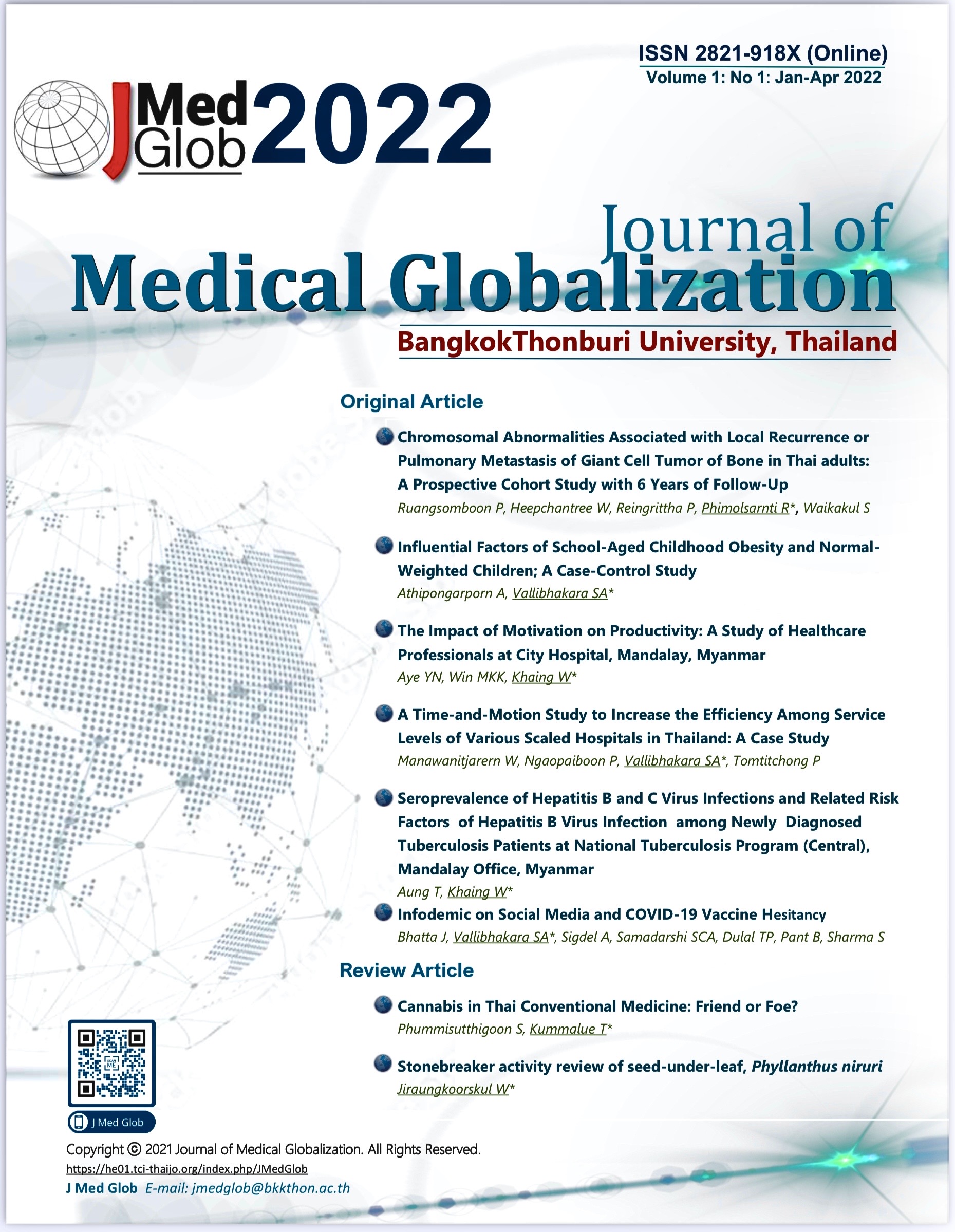Cannabis in Thai conventional medicine: Friend or foe?
Keywords:
Cannabis, conventional medicine, therapeutic useAbstract
Cannabis has been prescribed as medicine for over a hundred years, especially in the field of traditional medicine. Cannabis has various therapeutic properties, such as analgesic and sedative properties, to relax patients’ minds and relieve pain symptoms. Under the restriction for over decades, recently cannabis has been taken out of regulations with the permission of the Thai government. Nowadays, there are two fields of cannabis usage in Thailand, i.e., conventional medicine, which uses cannabis oil as complementary and alternative medicine, and traditional medicine, which uses cannabis in the form of cannabis oil and crude extract of leaves, including stems and roots in the mixture. This article will briefly review the benefits and adverse events (AEs) of cannabis use in conventional medicine, including the endocannabinoid system and cannabinoid receptors.
Keywords: Cannabis; Conventional medicine; Therapeutic use
References
Hand A, Blake A, Kerrigan P, Samuel P, Friedberg J. History of medical cannabis. J Pain Manage. 2016;9(4):387-94.
Lu H, Mackie K. An introduction to the endogenous cannabinoid system. Biol Psychiatry. 2016;79(7):516-25.
Nomura DK, Morrison BE, Blankman JL, Long JZ, Kinsey SG, Marcondes MC, et al. Endocannabinoid hydrolysis generates brain prostaglandins that promote neuroinflammation. Science. 2011;334:809-13.
Murataeva N, Straiker A, Mackie K, Parsing the players: 2-arachidonoylglycerol synthesis and degradation in the CNS. Br J Pharmacol. 2014;171:1379-91.
Di Marzo V, Fontana A, Cadas H, Schinelli S, Cimino G, Schwartz JC, et al. Formation and inactivation of endogenous cannabinoid anandamide in central neurons. Nature. 1994;372:686-91.
Howlett A, Abood M. CB1 and CB2 receptor pharmacology. Adv Pharmacol. 2017;80:169-206.
Zou S, Kumar U. Cannabinoid receptors and the endocannabinoid system: Signaling and function in the central nervous system. Int J Molec Sc. 2018;19:833-56.
Bile B, Wu J, Foss J, Naguib M. An overview of the cannabinoid type 2 (CB2) receptor system and its therapeutic potential. Curr Opin Anaesthesiol. 2018;31(4):407-14.
Busquets-Garcia A, Bains J, Marsicano G. CB1 receptor signaling in the brain: Extracting specificity from ubiquity. Neuropsychopharmacol. 2018;43:4-20.
Mackie K. Distribution of cannabinoid receptors in the central and peripheral nervous system. Handb Exp Pharmacol. 2005;299-325.
Nogueras-Oritz C, Ydowski GA. The multiple waves of cannabinoid 1 receptor signaling. Mol Pharmacol. 2016;90:620-6.
Howlett AC, Barth F, Bonner TI, Cabral G, Casellas P, Devane WA, et al. Classification of cannabinoid receptors. Pharmacol Rev. 2002;54:161-202.
Dhopeshwarkar A, Mackie K. CB2 cannabinoid receptor as a therapeutic target-what does the future hold? Mol Pharmacol. 2014;86:430-7.
Pellati F, Borgonetti V, Brighenti V, Biagi M, Benvenuti S, Corsi L. Cannabis sative L. and nonpsychoactive cannabinoids: Their chemistry and role against oxidative stress, inflammation, and cancer. BioMed Res Int. 2018. https://doi.org/10.1155/2018/1691428.
Kocis P, Vrana K. Delta-9-tetrahydrocanabinol and cannabidiol drug-drug interaction. Med Cannabis Cannabinoids. 2020;3:61-73.
Zendulka O, Dovetelova G, Noskova K, Turjap M, Sulcova A, Hanus L, et al. Cannabinoids and cytochrome P450 interactions. Curr Drug Met. 2016;17(3):1-21.
Grof C. Cannabis, from plant to pill. British J Pharmacol. 2018;84:2463-7.
Lee J, Bertoglio L, Guimaraes F, Stevenson C. Cannabidiol regulation of emotion and emotional memory processing: relevance for treating anxiety-related and substance abuse disorders. British J Pharmacol. 2017;174:3242-556.
Guidance on cannabis for medical use. Department of Medical Services, Ministry of Public Health. 2nd revision, 2019.
Malfitano A, Proto M, Bifulco M. Cannabinoids in the management of spasticity associated with multiple sclerosis. Neuropsychiatric Dis Treat. 2008;4(5):847-53.
Murnion B. Medicinal cannabis. Aust Prescr. 2015;38:212-5.
Ablin J, Ste-Marie PA, Schafer M, Hauser W, Fitzharles MA. Medical use of cannabis products. Schmerz. 2016;30:3-13.
Whiting P, Wolff R, Deshpande S, Nisio M, Duffy S, Hernandez A, et al. Cannabinoids for medical use: A systemic review and meta-analysis. JAMA. 2015;313(24):2456-73.
Seltzer E, Watters A, MacKenzie D, Granat L, Zhang D. Cannabidiol (CBD) as a promising anti-cancer drug. Cancer. 2020;12:3003.
Scully C. Cannabis; adverse effects from an oromucosal spray. British Dental J. 2007. Doi:10.1038/bdj.2007.749.
Volkow N, Baler R, Compton W, Weiss S. Adverse Health effects of marijuana use. N Engl J Med. 2014;370(23):2219-27.
Galli J, Sawaya R, Friedenberg F. Cannabinoid hyperemesis syndrome. Curr Drug Abuse Rev. 2011;4(4):241-9.
Larsen C, Shahinas J. Dosage, efficacy and safety of cannabidiol administration in adults: A systematic review of human trials. J Clin Med Res. 2020;12(3):129-41.
Published
How to Cite
Issue
Section
License
Copyright (c) 2022 Journal of Medical Globalization

This work is licensed under a Creative Commons Attribution-NonCommercial 4.0 International License.








